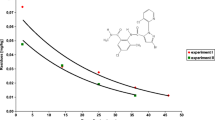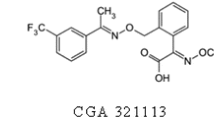Abstract
The concentration of thiram in aqueous solution decreases by 50–75% within 20 min in the presence of cut pieces of apple, cucumber or celeriac with a section surface area of 160 cm2 each. The decomposition rate is predominantly influenced by the section surface area of the cut fruit and vegetable samples. Denaturing reaction conditions (exchange of the solvent water by methanol; boiling of sample material) will significantly slow down the decomposition rate. It was concluded that the thiram decomposition had been caused by enzymes on the section surface of the fruit and vegetable samples. For a specific determination of thiram, a simple rinsing of the intact fruit and vegetable material was appropriate as extraction method. For the screening of thiram residues, the often used Keppel method, which determines CS2 from thiram or dithiocarbamates seems to be applicable even if samples had been coarsely cut, since decomposition of the CS2-forming intermediates is slower than the breakdown of thiram itself. Therefore, specific determination of thiram is necessary only, if maximum residue limits for dithiocarbamates are not adhered to.
Similar content being viewed by others
Author information
Authors and Affiliations
Additional information
Received: 20 August 1999 / Revised: 20 October 1999 / Accepted: 25 October 1999
Rights and permissions
About this article
Cite this article
Heise, S., Weber, H. & Alder, L. Reasons for the decomposition of the fungicide thiram during preparation of fruit and vegetable samples and consequences for residue analysis. Fresenius J Anal Chem 366, 851–856 (2000). https://doi.org/10.1007/s002160051584
Issue Date:
DOI: https://doi.org/10.1007/s002160051584




